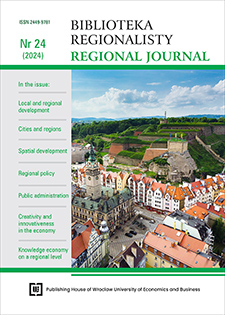New York as an example of the impact of megatrends on megacities – urbanization and inequalities
DOI:
https://doi.org/10.15611/br.2024.1.08Keywords:
megacities, New York, urbanization, social inequalitiesAbstract
Aim: The purpose of this paper is to study relationships between two megatrends: accelerating urba-nization and widening socio-income inequalities in megacities, based on the example of New York in 2018-2023.
Methodology: Research methods used to create this article include literature analysis, logical analysis, construction method, and case study.
Results: The study identifies that inequalities in megacities arise as a result of three different urba-nization processes: migration, industrialization, and the development of urban infrastructure.
Implications and recommendations: The article presents recommendations for reducing social and income inequalities in megacities and proposes solutions to other urbanization-related issues, such as environmental pollution and imperfections of crisis management procedures.
Originality/value: The article makes a contribution to the discussion on the effects of urbanization in megacities, offering an interdisciplinary perspective of social inequalities.
Downloads
References
Allen, A. (2025). New York’s history is multiculturalism at its finest. Insight Vacations. https://www.insightvacations.com/blog/new-yorks-history/
American Immigraton Council. (2022). New Americans in New York. https://map.americanimmigrationcouncil.org/locations/new-york/#
Dziemianowicz, W. i Jurkiewicz, I. (red.). (2023). Megatrendy społeczno-gospodarcze w kontekście koncepcji Rozwoju Kraju 2050. Trendy światowe. Instytut Rozwoju Miast i Regionów.
Gascon, C., i Haas, J. (2020). The impact of COVID-19 on the residential real estate market. The Regional Economist, 28(4). https://www.stlouisfed.org/publications/regional-economist/fourth-quarter-2020/impact-covid-residential-real-estate-market
Główny Urząd Statystyczny. (b.d.). Pojęcia stosowane w statystyce publicznej. https://stat.gov.pl/metainformacje/slownik-pojec/pojecia-stosowane-w-statystyce-publicznej/3078,pojecie.html
Gomstyn, A. i Jonker, A. (2023). What is a smart city?. IBM. https://www.ibm.com/topics/smart-city
Gujral, V., Palter, R., Sanghvi, A. i Vickery, B. (2020). Commercial real estate must do more than merely adapt to Coronavirus. McKinsey & Company. https://www.mckinsey.com/industries/private-capital/our-insights/commercial-real-estate-must-do-more-than-merely-adapt-to-coronavirus#/
Institute for Economics & Peace. (2023). Ecological threat report 2023: Analysing ecological threats, resilience & peace. https://reliefweb.int/report/world/ecological-threat-report-2023
Kawlra, G., & Sakamoto, K. (2023). Spatialising urban health vulnerability: An analysis of NYC’s critical infrastructure during COVID-19. Urban Studies, 60(9), 1629-1649. https://www.ncbi.nlm.nih.gov/pmc/articles/PMC10311382/
Klayman, L. (2024). The evolution of New York City: The Impact of the Industrial Revolution on Its Historical Heritage. Respect Brooklyn. https://www.respectbrooklyn.org/the-impact-of-the-industrial-revolution-on-new-york-s-historical-heritage
Kucharczyk-Capiga, J. (2019). Człowiek w świecie VUCA. PwC. https://www.pwc.pl/pl/artykuly/2019/czlowiek-w-swiecie-VUCA.html
Lankevich, G. (2024). New York City. Encyclopedia Britannica. https://www.britannica.com/place/New-York-City
Martin, P. (2014). Trends in migration to the U.S. PRB. https://www.prb.org/resources/trends-in-migration-to-the-u-s/
NYC Health. (2022). NYSDOH and NYCDOHMH wastewater monitoring identifies polio in New York City and Urge Unvaccinated New Yorkers to get vaccinated now. https://www.nyc.gov/site/doh/about/press/pr2022/nysdoh-and-nycdohm-wastewater-monitoring-finds-polio-urge-to-get-vaccinated.page
NYU Furman Center. (2018). State of New York City’s housing and neighborhoods in 2018. https://furmancenter.org/files/sotc/2018_SOC_Full_2018-07-31.pdf
Office of the State Government Accountability. (2021). LinkNYC program revenues and monitoring. https://www.osc.ny.gov/state-agencies/audits/2021/07/30/linknyc-program-revenues-and-monitoring
Patyk, A. (2023). Do 2050 przybędzie 14 nowych megamiast! Ogromny wzrost w Afryce. Obserwator Gospodarczy. https://obserwatorgospodarczy.pl/2023/01/20/do-2050-roku-przybedzie-14-nowych-megamiast-ogromny-wzrost-w-afryce/
Poverty Tracker Research Group at Columbia University. (2024). The state of poverty and disadvantage in New York City. Volume 6. RobinHood. https://d3nz95d6hm31un.cloudfront.net/uploads/2024/02/Annual-Poverty-Tracker-Report-2024.pdf
Service areas. Bed bug treatment throughout the tri-state area. (2022). Thermal Bedbug Heat. https://www.thermalbedbugheat.com/service-areas/
Szymańska, D. i Biegańska, J. (2011). Fenomen urbanizacji i procesy z nim związane. Studia Miejskie, 4, 13-38. https://www.studiamiejskie.uni.opole.pl/wp-content/uploads/2016/04/bieganska_szymanska.pdf
UM Warszawa. (2022). Przestrzenno-komunikacyjna rewolucja w Nowym Jorku. https://um.warszawa.pl/waw/strategia/-/nowy-jork
Understanding megacities: Dynamics and realities of urban centers worldwide. (2024). Wilo. https://wilo.com/en/Pioneering/Stories/Understanding-Megacities-Dynamics-and-Realities-of-Urban-Centers-Worldwide_40512.html
United Nations. (b.d.). Around 2.5 billion more people will be living in cities by 2050. https://www.un.org/en/desa/around-25-billion-more-people-will-be-living-cities-2050-projects-new-un-report
United Nations. (2019). World urbanization prospects: The 2018 revision (ST/ESA/SER.A/420). Department of Economic and Social Affairs, Population Division.
U.S. Bureau of Economic Analysis. (2024). County and MSA gross domestic product (GDP), summary Real Gross Domestic Product (GDP): United States and New York-Newark-Jersey City, NY-NJ-PA (Metropolitan Statistical Area) 2024. https://www.bea.gov/
U.S. Bureau of Labor Statistics. (2024). Consumer Price Index, New York-Newark-Jersey City-July 2024. https://www.bls.gov/regions/northeast/news-release/consumerpriceindex_newyork.htm
U.S. Census Bureau. (2024a). American Community Survey – ACS data profiles. U.S. Department of Commerce. https://data.census.gov/cedsci/
U.S. Census Bureau. (2024b). Historical income inequality tables (Table A-4a: Selected measures of household income dispersion). U.S. Department of Commerce. https://www.census.gov/data/tables/time-series/demo/income-poverty/historical-income-inequality.html
U.S. Census Bureau. (2024c). Population of the New York-Newark-Jersey City metro area in the United States from 2010 to 2023. https://www.statista.com/statistics/815095/new-york-metro-area-population/
Węcławowicz, G. (2003). Geografia społeczna miast. Zróżnicowania społeczno-przestrzenne. Wydawnictwo Naukowe PWN.
Downloads
Published
Issue
Section
License
Copyright (c) 2025 Patrycja Klasa, Katarzyna Cłapa

This work is licensed under a Creative Commons Attribution-ShareAlike 4.0 International License.
Accepted 2024-12-11
Published 2025-01-31







